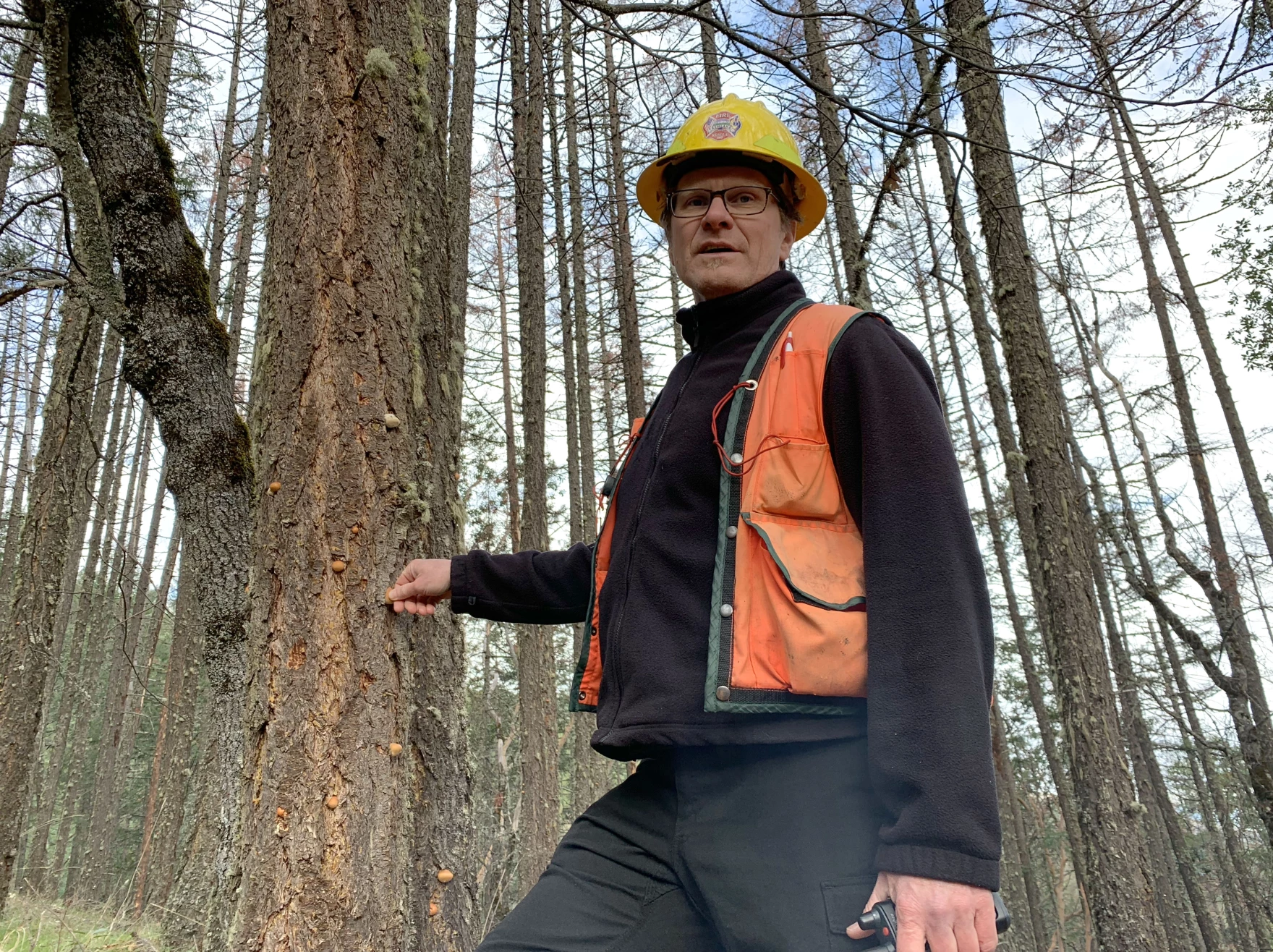
Ashland Fire and Rescue Wildfire Division Chief Chris Chambers standing in Siskiyou Mountain Park where crews were cutting down dead Douglas fir trees in an undated photo.
Erik Neumann / JPR
On a clearing overlooking Siskiyou Mountain Park in Ashland, a navy blue helicopter is making laps back and forth up the forested hillside. A long cable hangs down and on each pass the helicopter picks up three or four large trees, stripped of their branches. It ferries them down the mountain to a log truck that’s waiting below.
“They’re shooting to get 20 loads per hour. Yesterday they got 174 loads,” says Chris Chambers, the wildfire division chief with Ashland Fire and Rescue. He’s helping coordinate this project in which they’re thinning trees on around 500 acres.
In areas of this forest, anywhere from 20-80% of the fir trees are dead, he says. Experts are calling it a decline spiral. Others are calling it “firmageddon.” Chambers worries it’s increasing the number of dead trees that could burn in future wildfires.
“There are many, many neighborhoods right at the bottom of the slope here at Siskiyou Mountain Park. The vast majority of what is dead are right next to those neighborhoods,” he says.
He’s also worried that a large wildfire could permanently change this forest if hotter temperatures driven by climate change make it hard for fir trees to grow back after a fire. He says this thinning work will help soften the blow.
“This forest as we know it is going away. There’s going to be a new forest in the next decade to two decades. And if we don’t stay ahead of it, then we might not have a forest in 20, 30, 40 years,” Chambers says.
The work in the Ashland watershed is aimed at the symptoms of the Douglas fir die-off. But it doesn’t explain why the trees are dying in the first place.
Trees on the edge
On a hiking trail just outside of Jacksonville, Oregon, Max Bennett is staring up at a collection of fir trees.
“We’ve tagged these trees. There’s a little metal tag on the other side,” Bennett says, peering upward.
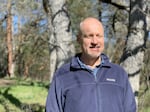
Retired Oregon State University Extension forester Max Bennett in an undated photo. Bennett co-authored "Trees on the Edge," a report that documents the Douglas fir decline spiral in Southern Oregon.
Erik Neumann / JPR
Bennett is a retired Oregon State University extension forester. He’s been researching this fir tree die-off, and he co-authored a 2023 paper called “Trees on the Edge.” As the name of his report suggests, this forest in Jacksonville is an environment that’s right on the edge of where Douglas fir trees can grow. That means it just takes a little change in conditions — like drought or hotter summers — to push them over the edge.
“Those two things: not enough rainfall and higher temperatures, particularly in the summer, are what people are talking about much more now as hotter drought. It’s not just drought the way we normally think about it, it’s hotter drought,” he says.
That combination of above-average temperatures and below-average precipitation is stressing out Douglas fir trees. Bennett suspects these conditions are messing with trees’ ability to pull water up from their roots.
“The hotter it is and the dryer it is, the more pull, the more draw from the atmosphere. It’s like a straw. You’re sucking really hard on that straw, and instead of liquid, you draw in air,” he says. “Think of it as a tree heart attack in a way.”
Southwest Oregon is being especially affected by hot drought conditions because there’s so little water here to begin with.
If hot drought is the first factor driving the die-off, the second one is a little metallic-green bug.
Climate change in real time
On a hillside midway up Woodrat Mountain in the Applegate Valley, Laura Lowrey swings an ax into the bark of a standing, dead Douglas fir tree.
“I usually try to make a square,” she says between swings. “You can peel the bark off these long-dead trees.”
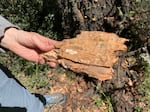
Entomologist Laura Lowrey holds bark from a dead Douglas fir to show flatheaded fir borer tracks in an undated photo.
Erik Neumann / JPR
Lowrey is an entomologist for the U.S. Forest Service and the Bureau of Land Management. She’s trying to look under the bark to find the squiggly tracks of an insect called the flatheaded fir borer.
She rips off a chunk of bark. Inside are little tunnels where the insect’s larvae have chewed. On the outside, tiny jewels of pitch or sap show where fir borers went in and the tree tried to stop them.
These bugs aren’t inherently bad.
“They are more of the cleanup crew. They’re not tree killers themselves. They’re more like, trees are dying, now they’re helping recycle them, turn them into soil,” Lowrey says.
Fir borers smell stress signals from trees that aren’t healthy, she explains. But now, with so many dead and dying trees in the area, the beetle population has exploded; it’s even overwhelming healthy green trees.
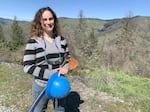
Entomologist Laura Lowrey at Woodrat Mountain overlooking the Applegate Valley in an undated photo.
Erik Neumann / JPR
Before Oregon, Lowrey worked in Idaho and the Rocky Mountains where she studied other types of beetle outbreaks. She says they went in cycles: The outbreak would grow, then peak and then crash as predators caught up.
“Here, we don’t get the sense that this outbreak is crashing,” she says.
In “Trees on the Edge,” for which Lowrey contributed aerial survey work, the acres with Douglas fir mortality attributed to the flatheaded fir borer jumps from a high of about 50,000 acres in 2019 to around 375,000 acres in 2022.

A graph published in "Trees on the Edge": "Acres with Douglas-fir mortality attributed to flatheaded fir borer by severity class. The estimate for the number of acres affected is based on aerial sketchmaps that show the general areas Douglas-fir dieback has occurred. It does not necessarily mean that all or even most of the Douglas-fir trees in those areas have been killed. Instead, the estimate represents a mosaic of trees that were recently killed and living trees. Aerial survey data are most appropriate for monitoring damage and mortality trends at a watershed scale. They do not provide precise estimates of the number of trees killed or the area affected."
Laura Lowery via Max Bennett / U.S. Forest Service, OSU Extension Service
Lowrey has done aerial surveys over all types of federal lands across Southern Oregon, scanning out of plane windows for dying firs. She says when she moved here just four years ago there weren’t nearly as many stands of dead trees.
“We’re like, ‘Wow, it’s very fast. It’s real time. Watching the effects of climate change in real time,’ which is an odd feeling to say the least,” she says.
In response to the fir die-off, the BLM is doing thinning on 5,000 of the 876,000 acres managed by the Medford District. Officials say the projects will be meant to protect communities and roads. They’re planning to cut down trees, some of which will be sold as timber. They’ll also do prescribed fire operations. The BLM’s proposed environmental assessment for the project, on which the public can comment, will be released in early summer.
But some Rogue Valley residents say the BLM and the city of Ashland are motivated by timber sales, not forest health or public safety.
“One of our contentions is what they’re calling hazard tree removal, is starting to look, feel and function much more like unit logging and much more like broadscale clearcutting than clearing hazards adjacent to the road,” says longtime Applegate resident Luke Ruediger.
He argues that these beetle-killed trees would be better left as standing snags for animal habitat like birds that eat the fir borers. And, he says, these same areas have been thinned in the past. He believes aggressive forest management now will make the area more vulnerable to drought and beetle mortality in the future.
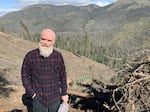
Applegate Siskiyou Alliance executive director Luke Ruediger standing in front of a clearcut at the Lickety Split timber sale on land managed by the BLM in the Little Applegate Valley in an undated photo.
Erik Neumann / JPR
“I don’t think it’s a coincidence that right now the areas being targeted for salvage logging are also some of the areas that have been the most heavily managed by the BLM, by the city of Ashland, and by the Rogue River-Siskiyou National Forest,” Ruediger says.
A better way to protect communities, he argues, is to help residents who live around these forests create defensible space and take steps to harden their homes from the risks of wildfires.
Helping trees track climate change
Five miles north, in Central Point, Bryan Reatini is standing in a big green grid of Douglas fir trees in the middle of a farm field. He examines a tag on one of the trees.
“This block is ‘Oregon Cascade low,’ which makes sense. This is around where we are at locally,” he says.
Reatini is a geneticist with the Forest Service, and he’s at J. Herbert Stone Nursery. The trees here are examples of Douglas firs that have been cultivated from different seed sources across the species’ range. The grid is part of a project to study climate adaptation so that land managers across the West Coast can help forests withstand future climate scenarios.
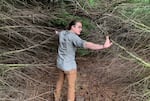
Forest Service Geneticist Bryan Reatini walks into a research plot of Douglas fir trees at J. Herbert Stone Nursery in Central Point, Ore., in an undated photo.
Erik Neumann / JPR
He walks into one section where the firs are not looking great. They’re scraggly and stunted. Some have gone from green to orange.
“Washington coast,” he says. “A very different environment. And as you can see, they’re not doing very well here, are they?”
There’s wide genetic diversity, even within a single species like Douglas fir, he explains. Fir trees that are adapted to the Washington coast are not suited to Southern Oregon. But others from warmer climates might grow better here as temperatures increase.
“By transferring seeds from those environments that have adapted to those conditions, to where those conditions exist now presently, we can essentially help trees track climate change,” he says.
The steps they’re taking are conservative. They might plant seedlings just a thousand feet higher in elevation from their original source. Researchers are trying to mimic how trees would naturally shift, he says, if climate change wasn’t happening so fast.
The bigger goal for Reatini’s team is to help land managers plan ahead when reforesting places like the hills around Ashland or the Applegate Valley.
“I think we have our work cut out for us for sure. I think we’re behind and things like the Douglas fir decline spiral are examples of that. But I am optimistic that we are going to be able to maintain healthy forest populations. It’s going to require a lot of thinking and a lot of effort and a lot of innovation but yes, I absolutely think we can accomplish that goal,” he says.
In the years ahead, he says, they expect to see changes to tree species’ ranges. Douglas fir trees in Southern Oregon are just one example where the effects of climate change will slowly be revealed.


